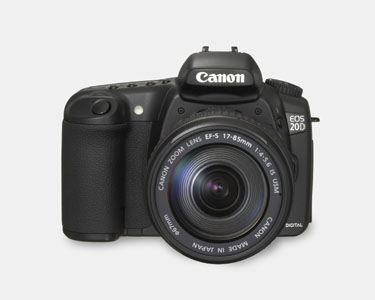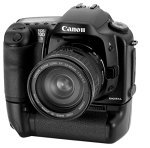JimDoty.org |
||||||||||||||
|
|
||||||||||||||
Support This Site
This site in: |
||||||||||||||
Canon 10D vs 20D |
|||||
 |
|||||
With each new generation, digital cameras just keep getting better. In their line of intermediate level digital SLRs, Canon has introduced the D30 ($3300),
the D60 ($2200), the 10D ($1500), and now the 20D ($1450). Each is an improvement over the previous model. The same could be said for Nikon and other camera makers - cameras get better and prices usually drop.
The Canon 20D is a step forward from the 10D, but in many areas this is just an incremental step.
First of all, the biggest non-change. The 20D has the same 1.6X field of view crop
as the 10D and Digital Rebel. Due to an image sensor that is smaller than 35mm film, all images are cropped. This means the effective focal length of a lens is 60% longer than when the same lens is used on a 35mm film camera. For example, a 100mm lens on a 20D has the same field of view as a 160mm lens on a 35mm film camera. This is great for long lens work, but not good for wide angle work.
Here are some of the differences, both great and small. 10D: 6 megapixel sensor 10D: 2.5 second start up time 10D: 3.3 frames per second, 9 frame buffer 10D: 1/4000 top shutter speed 10D: 1/200 X sync 10D: 5 point autofocus system The autofocus system on the 20D is faster and more accurate than on the 10D and works in lower light. The built
in pop-up flash is higher than on the 20D so it clears more lenses and hoods (less chance of dark partial circles at the bottom of the frame). It also means less red eye. The 20D is smaller and lighter. The 10D and 20D have essentially the same noise levels from ISO 100-400 but the 20D has less digital noise at ISO 800 and higher.
The 20D has USB 2.0 for faster downloads to a computer. The 20D has a black and white mode to emulate typical black and white filters used with film cameras. The 20D has true RAW + jpeg support. It can write two separate files to the flash card, one in RAW and one in jpeg. You can read the jpeg version of a photo without special software. The 10D embeds the jpeg in the raw file data so you need special software to extract he jpeg file. The 20D has a two axis white balance menu option, blue - amber, and magenta - green. The 20D takes the new EF-S lenses. The 20D has a louder shutter than the 10D, a disadvantage. So what changes matter? That will depend on what you shoot and how. Here is how it stacks up for me. The 2 megapixel gain in sensor size is
not a big change. If you work at lower ISOs, the image quality between the 10D and 20D is going to be essentially the same. The 10D can already provide 12x18 inch and larger prints with excellent quality. If you do a
lot of low light work without flash, the lower noise levels in the 20D at 800 and 1600 could be important. The 20D will allow some cropping and still have an image file as big as one from an uncropped file from
the 10D. Waiting for the 10D to turn on (or wake up) when a fleeting shot appears can be frustrating. The virtually instant response of the 20D is a big difference. If you take your time and shoot mainly
landscapes and other subjects that don't change or run away, this is no big deal. If you do action photography, the faster autofocus is a big asset. Shooting 5 frames per second is not a big deal for me, but having a 23 frame buffer is a big deal for fast and furious sports and wildlife action. I use the built in flash a lot for snapshots. The higher pop-up flash height is a big advantage in reducing red eye and avoiding dark areas at the bottom of the frame. If you love wide angle work, being able to use the Canon EF-S 10-22mm lens on your 20D (or Digital Rebel) is a big advantage. On the 20D the field of view of the 10-22mm lens is the same as a using a 16-32mm lens on a 35mm camera body. This is the first lens that allows true wide angle work with a digital camera body with a 1.6X field of view crop. The EF-S lenses won't work on Canon film bodies (even if the lens is modified). You can use the EF-S 10-22mm lens on a 10D body if you cut off part of the back of the EF-S lens mount. I don't recommend this but a search on the internet will tell you how to do this and the risks involved. Should you buy this camera? That all depends. If the $1450
price tag is not an issue, then here are some considerations. If you are shooting film now and are thinking about jumping to digital and you have Canon EF lenses already, this camera makes the jump to digital very
worthwhile. I bought a 10D a year and a half ago and it was a great decision. (See my If you have a 10D now, you will have to look above at the improvements in the 20D and see if they matter in your shooting. I don't see much advantage in upgrading for landscape photographers, and I see more reason to
upgrade for sports and action photographers. For low light users, it is a mixed bag. The lower noise levels are offset in part by the louder shutter. I do low light level work at church services and a louder shutter is
a big disadvantage. If you have bunch of Nikon lenses and you are happy with them, it would make sense to get a Nikon D70 if you want to jump to digital. It is a better camera than the Canon Digital Rebel and
marginally better than the Canon 10D (except perhaps for astrophotography, see the link below). The Canon 20D has an image quality edge over the D70, but Nikon will come out with an improved model, then Canon will, and
so on. The competition is good for all of us. This applies to other brands of cameras also. GOOD LENSES ARE FOREVER (more or less), DIGITAL BODIES ARE TEMPORARY. If you have a good collection of lenses that you
like, find a digital body that will work with your current lenses. If your lenses are orphaned without a good digital body to use them on, then a Canon 20D and some Canon EF or EF-S lenses would serve you well |
|
|
|
|
|
|





